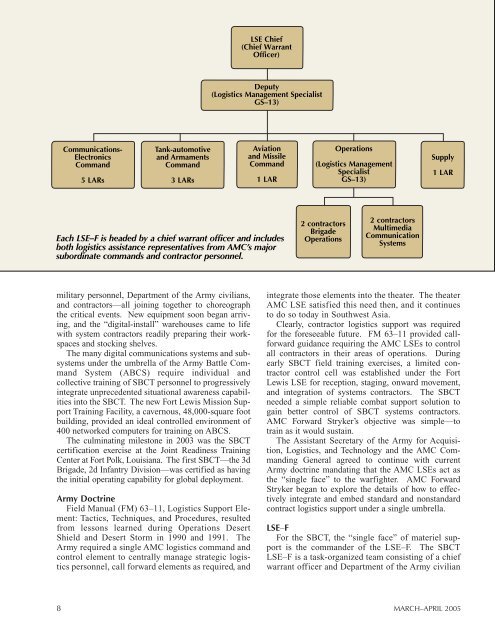Life-Cycle Management - Army Logistics University - U.S. Army
Life-Cycle Management - Army Logistics University - U.S. Army
Life-Cycle Management - Army Logistics University - U.S. Army
Create successful ePaper yourself
Turn your PDF publications into a flip-book with our unique Google optimized e-Paper software.
8<br />
Communications-<br />
Electronics<br />
Command<br />
5 LARs<br />
Tank-automotive<br />
and Armaments<br />
Command<br />
3 LARs<br />
Each LSE–F is headed by a chief warrant officer and includes<br />
both logistics assistance representatives from AMC’s major<br />
subordinate commands and contractor personnel.<br />
military personnel, Department of the <strong>Army</strong> civilians,<br />
and contractors—all joining together to choreograph<br />
the critical events. New equipment soon began arriving,<br />
and the “digital-install” warehouses came to life<br />
with system contractors readily preparing their workspaces<br />
and stocking shelves.<br />
The many digital communications systems and subsystems<br />
under the umbrella of the <strong>Army</strong> Battle Command<br />
System (ABCS) require individual and<br />
collective training of SBCT personnel to progressively<br />
integrate unprecedented situational awareness capabilities<br />
into the SBCT. The new Fort Lewis Mission Support<br />
Training Facility, a cavernous, 48,000-square foot<br />
building, provided an ideal controlled environment of<br />
400 networked computers for training on ABCS.<br />
The culminating milestone in 2003 was the SBCT<br />
certification exercise at the Joint Readiness Training<br />
Center at Fort Polk, Louisiana. The first SBCT—the 3d<br />
Brigade, 2d Infantry Division—was certified as having<br />
the initial operating capability for global deployment.<br />
<strong>Army</strong> Doctrine<br />
Field Manual (FM) 63–11, <strong>Logistics</strong> Support Element:<br />
Tactics, Techniques, and Procedures, resulted<br />
from lessons learned during Operations Desert<br />
Shield and Desert Storm in 1990 and 1991. The<br />
<strong>Army</strong> required a single AMC logistics command and<br />
control element to centrally manage strategic logistics<br />
personnel, call forward elements as required, and<br />
LSE Chief<br />
(Chief Warrant<br />
Officer)<br />
Deputy<br />
(<strong>Logistics</strong> <strong>Management</strong> Specialist<br />
GS–13)<br />
Aviation<br />
and Missile<br />
Command<br />
1 LAR<br />
Operations<br />
(<strong>Logistics</strong> <strong>Management</strong><br />
Specialist<br />
GS–13)<br />
2 contractors<br />
Brigade<br />
Operations<br />
2 contractors<br />
Multimedia<br />
Communication<br />
Systems<br />
Supply<br />
1 LAR<br />
integrate those elements into the theater. The theater<br />
AMC LSE satisfied this need then, and it continues<br />
to do so today in Southwest Asia.<br />
Clearly, contractor logistics support was required<br />
for the foreseeable future. FM 63–11 provided callforward<br />
guidance requiring the AMC LSEs to control<br />
all contractors in their areas of operations. During<br />
early SBCT field training exercises, a limited contractor<br />
control cell was established under the Fort<br />
Lewis LSE for reception, staging, onward movement,<br />
and integration of systems contractors. The SBCT<br />
needed a simple reliable combat support solution to<br />
gain better control of SBCT systems contractors.<br />
AMC Forward Stryker’s objective was simple—to<br />
train as it would sustain.<br />
The Assistant Secretary of the <strong>Army</strong> for Acquisition,<br />
<strong>Logistics</strong>, and Technology and the AMC Commanding<br />
General agreed to continue with current<br />
<strong>Army</strong> doctrine mandating that the AMC LSEs act as<br />
the “single face” to the warfighter. AMC Forward<br />
Stryker began to explore the details of how to effectively<br />
integrate and embed standard and nonstandard<br />
contract logistics support under a single umbrella.<br />
LSE–F<br />
For the SBCT, the “single face” of materiel support<br />
is the commander of the LSE–F. The SBCT<br />
LSE–F is a task-organized team consisting of a chief<br />
warrant officer and Department of the <strong>Army</strong> civilian<br />
MARCH–APRIL 2005







